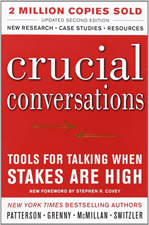|
Crucial Conversations by Kerry Patterson, Joseph Grenny, Ron McMillan, and Al Switzler was a groundbreaking addition to the Top Picks (recommendations) on the Doescher Advisors book list. It was published in 2002, and somehow I missed it at the time. This book is so practical and applicable, I have decided to memorialize the key points. In case you don't have the time to read the book, you will at least get the main takeaways - with, of course, some editorial comments. Here goes ...
- A crucial conversation is a discussion between two or more people where the stakes are high, opinions vary, and emotions run strong. (Editorial comment: Most people have several of those every week.)
- We usually handle crucial conversations one of three ways: we avoid them, we face them and handle them poorly, or we face them and handle them well.
- The negative feelings we hold in, the emotional pain we suffer, and the constant battering we endure as we stumble our way through unhealthy conversations slowly eats away at our health.
- At the core of every successful conversation is the free flow of relevant information, or a dialogue.
- Each of us enters conversations with our own opinions, feelings, theories, and experiences about the topic at hand.
- Remember that the only person you can directly control is yourself.
- Focus on what you really want for yourself, for others, and for the relationship. What is the mutual purpose of the conversation?
- Wanting to win or seeking revenge is a dialogue-killer.
- Stay alert for the moment a conversation turns from a routine or harmless discussion into a crucial one. As you anticipate engaging in a tough conversation, pay heed to the fact that you're about to enter the danger zone.
- When others start forcing their opinions into the pool of meaning, it's often because they figure that you're trying to win (versus having a healthy dialogue), and they believe they need to do the same.
- The instant people perceive disrespect in a conversation, the interaction is no longer about the original purpose - it's now about defending dignity. (Editorial comment: No matter what, we need to behave like healthy adults.)
- When you've made a mistake that has hurt someone, start with an apology. (Click here to read my November 11, 2013, blog.)
- As previously mentioned, both parties are often trying to force their view. Say to the other person, "I commit to stay in this discussion until we have a solution both of us are happy with."
- Other people don't make you angry; you and only you create your strong emotions. You either find a way to master them, or you fall hostage to them.
- Just after we observe what others do and just before we feel some emotion about it, we tell ourselves a story. We add meaning, motive, and judgment to the action we observed (i.e., he doesn't trust me, she thinks I'm weak, etc.). Then we respond with emotion. Don't confuse stories with facts. (Editorial comment: This point is huge. Has anyone ever said to you, "I know what he's thinking"? How do they know?)
- The three most common unhealthy stories: Victim Stories - "It's not my fault"; Villain Stories - "It's all your fault"; and Helpless Stories - "There's nothing else I can do."
- Am I pretending not to notice my role in the problem?
- Why would a reasonable, rational, and decent person do this?
- We should make sure we tell our story as a story, rather than disguising it as a fact (i.e., "I was wondering why ...").
- Most arguments consist of battles over the 5 to 10 percent of the facts and stories about which people disagree.
- Decide how to decide. The four methods of decision-making are: command, consult, vote, and consensus. To determine which method you're using, ask these four questions: Who cares? Who knows? Who must agree? How many people is it worth involving? (Editorial comment: My mentor used to say, "Be careful what you ask for.")
- Consult with others regarding a decision when: Many people will be affected; You can gather information relatively easily; People care about the decision; and There are many options, some of them controversial.
- To avoid common decision-making traps, make sure you consider the following four elements: Who? Does what? By when? How will you follow up?
I would still highly recommend reading the book, unless you live in a cave by yourself and have no contact with other people.
When I reflect on the really great leaders I personally know, I realize they're all experts at effectively handling crucial conversations. Let's all commit to improving our crucial conversation skills.
Seek. Climb. Lead.
|
|
 Order from Amazon
Order from Amazon



|

